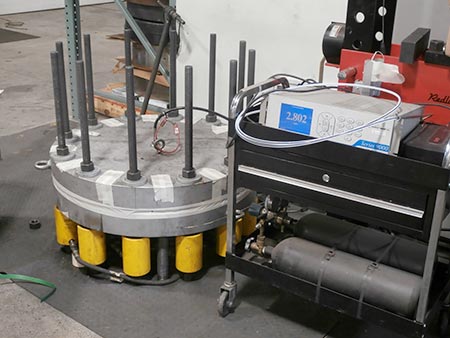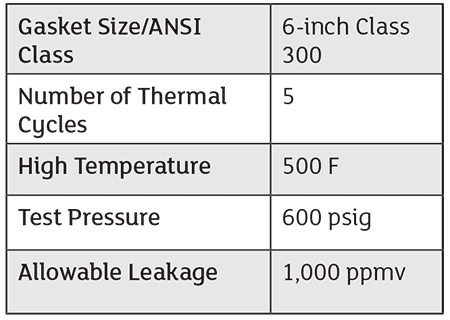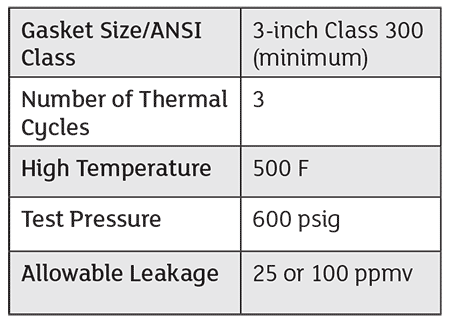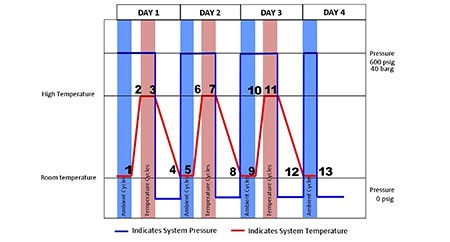
With the release of the Clean Air Act Amendments in 1990, fugitive emission testing on valves and other process equipment began promptly. Dynamic seals, such as valve stem seals, were a primary source of emissions and a priority for end users to examine.
It was not until the beginning of the 2000s that static seals gained attention. High leakages at refineries and other petrochemical plants were being observed on flange gaskets and other static seals, especially when they experienced thermal cycles. Some early tests were conducted by gasket manufacturers using their protocols. Typically, the testing was performed at room temperature using methane gas and measuring leakage as parts per million volume (ppmv) using leak detectors.

Standards Under Development
In 2004, David Reeves of ChevronTexaco contacted a valve testing service about gasket leakage he was experiencing at his facility in El Segundo, California. The two groups wrote the first fugitive emission test standard for flange gaskets, entitled: “Testing Protocol for Pipe Flange Gaskets.”
This standard, similar to the test standard written for valves, set parameters that are still used today in other API test standards (Image 1). While 1,000 ppmv was stated as the allowable leakage, that was never considered to be acceptable. The standard was written as a basis to begin some comparison testing and the 1,000 ppmv was the limit where a test would end. Most leakages were under 100 ppmv.
In 2010, Reeves needed to have gaskets tested at a higher temperature, so the “Chevron Ultra-High Temperature Gasket Test Procedure” was written. It included a 100-hour soak time at either 1,000 F or 800 F, depending on the gasket type. In 2011, the gasket test standard was modified and renamed the “Chevron Fugitive Emissions Test (CFET) Protocol for Pipe Flange Gaskets” and a couple of important changes were made. It was noticed in previous tests and in the field that often the outer diameter of the raised face would make hard contact with the outer metal ring of a spiral-wound gasket. Since these rings are often painted, testing showed that sealing could occur at that interface. To remove that variable from the testing results, this edition of the standard required grooves be cut into the outer ring in four positions on both sides of the gasket.
Also in this edition, the bolt torque was increased to 260 foot-pounds (ft-lb) from 200. To simulate the uneven heating in a heat exchanger, only one flange was heated to 500 F. The uneven heating was designed to create a radial shear on the gasket. The latest edit was in 2013 when the nut torque was decreased to 190 ft-lb.
Shell MESC SPE 85-300 & ISO 15848-1
Shell Oil has a history of writing its test standards for valve and gasket type acceptance testing. While the Material and Equipment Standards Code (MESC) Society of Petroleum Engineers (SPE) 85/300 consists of many tests for fugitive emissions, it specifies testing to International Organization for Standardization (ISO) 15848-1. The ISO standard is a fugitive emission test standard for valves. It comprises of criteria for mechanical and thermal cycles. Since mechanical cycles are not possible, then only the thermal cycles are performed. Although not specified, typically four thermal cycles are completed at the full rated pressure of the American National Standards Institute (ANSI) flanges. The four thermal cycles would simulate a CO3 endurance class for the ISO standard, which are most of the applications.
ASME B16.20
In 2017, the American Society of Mechanical Engineers (ASME) released a new edition of B16.20, “Metallic Gaskets for Pipe Flanges.” While most of the standard is a design standard, there are two important testing parts to it for spiral-wound gaskets. The “SW-2.2 Construction” section states a minimum thickness after being compressed to a stated stress level. “Section SW-2.6 Performance Testing” is a room temperature fugitive emission test performed with methane after a four-hour hold period. Since the specified compressive stress levels are lower for the leakage test that is performed first, the stress is then increased for the thickness test.

Fluid Sealing Association
In 2017, the Fluid Sealing Association (FSA) began creating a fugitive emission test standard for gaskets. The standard used the Chevron standard as a starting point but expanded the details of assembling the flange assembly and leakage measurement techniques to make it repeatable and precise. Research and development tests were performed by some gasket manufacturers and testing laboratories.
The basic parameters are shown in Image 2. The major variations from the Chevron specification include the reduction of thermal cycles to three and the reduction of allowable leakages with the option for two levels. Image 3 shows the temperature/pressure profile. The assembly of the parts is given in Appendix C of the standard. A gas containment sleeve around the outside diameter of the gasket is designed to capture leakage from around the circumference and pass it through the leak detector. An accurate and stable leak reading should be achievable with this method. The methane leak detector is calibrated according to the latest American Petroleum Institute 622 standard, providing repeatable ppmv readings of a leak independent of the sampling rate of the leak detector being used.

With the events of 2020, there has been some delay in publishing the standard. Currently, it is out for review with an expected release later this year.
We invite your suggestions for article topics as well as questions on sealing issues so we can better respond to the needs of the industry. Please direct your suggestions and questions to sealingsensequestions@fluidsealing.com.


